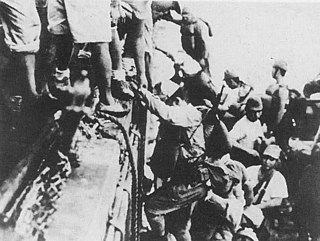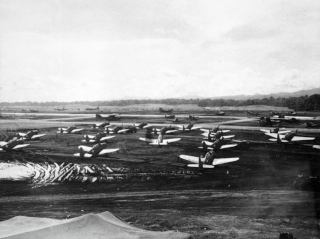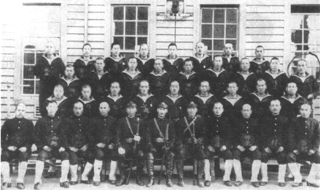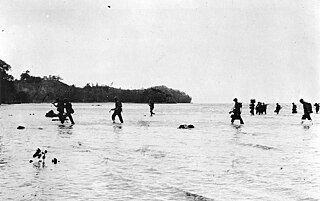
Solomon Islands is a sovereign state in the Melanesia subregion of Oceania in the western Pacific Ocean. This page is about the history of the nation state rather than the broader geographical area of the Solomon Islands archipelago, which covers both Solomon Islands and Bougainville Island, a province of Papua New Guinea. For the history of the archipelago not covered here refer to the former administration of the British Solomon Islands Protectorate, the North Solomon Islands and the History of Bougainville.

The Guadalcanal campaign, also known as the Battle of Guadalcanal and codenamed Operation Watchtower by American forces, was a military campaign fought between 7 August 1942 and 9 February 1943 on and around the island of Guadalcanal in the Pacific theater of World War II. It was the first major land offensive by Allied forces against the Empire of Japan.

The Tokyo Express was the name given by Allied forces to the use of Imperial Japanese Navy ships at night to deliver personnel, supplies, and equipment to Japanese forces operating in and around New Guinea and the Solomon Islands during the Pacific campaign of World War II. The operation involved loading personnel or supplies aboard fast warships, later submarines, and using the warships' speed to deliver the personnel or supplies to the desired location and return to the originating base all within one night so Allied aircraft could not intercept them by day.

The New Georgia campaign was a series of land and naval battles of the Pacific Theater of World War II between Allied forces and the Empire of Japan. It was part of Operation Cartwheel, the Allied strategy in the South Pacific to isolate the Japanese base around Rabaul. The campaign took place in the New Georgia Islands in the central Solomon Islands and followed the Allied capture of the Russell Islands. The main fighting took place on New Georgia itself, although significant actions also took place around the island chain throughout the campaign.

The Nggela Islands, previously known as the Florida Islands, are a small island group in the Central Province of Solomon Islands, a sovereign state, since 1978, in the southwest Pacific Ocean. The name, Florida Islands, fell into disuse following Solomon Islands' independence in 1978.

Cactus Air Force refers to the ensemble of Allied air power assigned to the island of Guadalcanal from August 1942 until December 1942 during the most heavily contested phases of the Guadalcanal Campaign, particularly those operating from Henderson Field. The term "Cactus" comes from the Allied code name for the island. In 1943, the Cactus Air Force was absorbed into AirSols, a joint command of Allied air units in the Solomon Islands.

Major Warren Frederick Martin Clemens was a Scottish colonial administrator and military officer. In late 1941 and early 1942, while serving as a District Officer in the Solomon Islands, he helped prepare the area for eventual resistance to Japanese occupation. His additional duties as a coastwatcher alerted the Allies to Japanese plans to build an airstrip on Guadalcanal. This resulted in Allied carrier raids and eventually a landing by United States forces and the beginning of the epic struggle in the Solomons. Clemens then directly served the U.S. Marines in coordinating intelligence on Japanese activities.

The Coastwatchers, also known as the Coast Watch Organisation, Combined Field Intelligence Service or Section C, Allied Intelligence Bureau, were Allied military intelligence operatives stationed on remote Pacific islands during World War II to observe enemy movements and rescue stranded Allied personnel. They played a significant role in the Pacific Ocean theatre and South West Pacific theatre, particularly as an early warning network during the Guadalcanal campaign.

The Solomon Islands campaign was a major campaign of the Pacific War of World War II. The campaign began with Japanese landings and capture of several areas in the British Solomon Islands and Bougainville, in the Territory of New Guinea, during the first six months of 1942. The Japanese occupied these locations and began the construction of several naval and air bases with the goals of protecting the flank of the Japanese offensive in New Guinea, establishing a security barrier for the major Japanese base at Rabaul on New Britain, and providing bases for interdicting supply lines between the Allied powers of the United States and Australia and New Zealand.

The British Solomon Islands Protectorate was first established in June 1893, when Captain Herbert Gibson of HMS Curacoa declared the southern Solomon Islands a British protectorate.

Henderson Field is a former military airfield on Guadalcanal, Solomon Islands, during World War II. Originally built by the Japanese Empire, the conflict over its possession was one of the great battles of the Pacific War. Today it is Honiara International Airport.

Sir Jacob Charles Vouza, was a native police officer of the British Solomon Islands Protectorate, who served with the United States Marine Corps in the Guadalcanal campaign during World War II.

The invasion of Tulagi, on 3–4 May 1942, was part of Operation Mo, the Empire of Japan's strategy in the South Pacific and South West Pacific Area in 1942. The plan called for Imperial Japanese Navy troops to capture Tulagi and nearby islands in the British Solomon Islands Protectorate. The occupation of Tulagi by the Japanese was intended to cover the flank of and provide reconnaissance support for Japanese forces that were advancing on Port Moresby in New Guinea, provide greater defensive depth for the major Japanese base at Rabaul, and serve as a base for Japanese forces to threaten and interdict the supply and communication routes between the United States and Australia and New Zealand.

The Battle of the Tenaru, sometimes called the Battle of the Ilu River or the Battle of Alligator Creek, was a land battle between the Imperial Japanese Army and Allied ground forces that took place on 21 August 1942, on the island of Guadalcanal during the Pacific campaign of World War II. The battle was the first major Japanese land offensive during the Guadalcanal campaign.

The Battle of Tulagi and Gavutu–Tanambogo was a land battle of the Pacific campaign of World War II, between the forces of the Imperial Japanese Navy and Allied ground forces. It took place 7–9 August 1942 on the Solomon Islands, during the initial Allied landings in the Guadalcanal campaign.
William Sydney Marchant was a British colonial administrator. He served as the Resident Commissioner of the Solomon Islands from 1939 to 1943.

Commander Eric Augustas Feldt was an officer in the Royal Australian Navy and the director of the Coastwatchers organisation for much of the Second World War.
Munda International Airport is an international airport adjacent to the town of Munda, Western Province in Solomon Islands.

The Yokohama Air Group was an aircraft and airbase garrison unit of the Imperial Japanese Navy Air Service during the Pacific campaign of World War II.

Donald Gilbert Kennedy was a teacher, then an administrator in the British colonial service in the Gilbert and Ellice Islands Colony and the British Solomon Islands Protectorate. For his services as a Coastwatcher during the Pacific War, he was awarded the DSO, and the Navy Cross (U.S.). He published journal articles and books on the material culture of Vaitupu atoll, land tenure, and the language of the Ellice Islands.

















